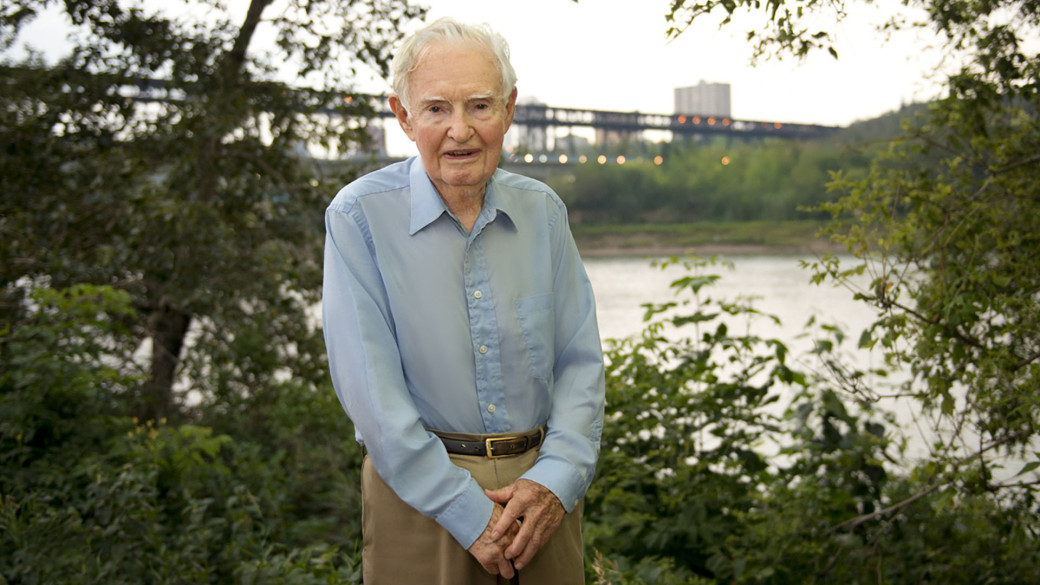Non-urgent government operations are closed December 24 to January 1, reopening January 2. View available services during this period.

"…he has breathed life into the dusty stuff of history."
An admirer's description of Tony Cashman's work
Tony Cashman is a celebrated historian, storyteller and playwright. As a gifted author of many engaging tales, he has an uncanny ability to bring the people in his stories to life and take his audiences on historical adventures through time.
Tony was born in Edmonton on April 29, 1923 in a house that remains standing today. He is the son of John Walcott Cashman, a mining engineer and Helen Gorman, a teacher, who came to Edmonton with their families in 1906 – the Cashmans from Orillia, Ontario and the Gormans from Chicago.
Tony describes his father as his “own personal war hero”, in action the first day tanks were used in battle in the First World War and earned the Military Medal for guiding those tanks into position under fire. Upon his return to Canada Tony’s father was involved in installing the revolutionary system of electric tramways in mining areas such as Idaho, Montana, and eventually abroad in South Africa, India and the Philippines. The family lived in various towns in the United States from 1927 to 1934, to be closer to their father’s work. In 1934, when Tony was 11 years old, his father died of Dengue fever while on a trip to the Philippines. Tony’s mother chose to move the family back to Edmonton, where he immediately felt like he was home. Tony entered Grade 7 at Grandin School, and having previously attended school in the United States, he realized that history was a matter of perception. For example, he learned two different versions of the war of 1812 where the same people were wonderful in one version and awful in the other.
These were the depression years, but Tony recalls that children were hardly aware of it. They were more aware that the Second World War was looming. Tony was fascinated with aviation and grew up in awe of his uncle George Gorman, who had been a pilot in the First World War and afterwards one of the first Edmonton bush pilots. Pilots were the celebrities of the era, and when news of another war came, Tony enlisted in the air force and served as a navigator in Bomber Command, participating in 30 missions over Germany.
After the War, Tony attended Notre Dame University in South Bend, Indiana before returning to Edmonton and beginning his career as a journalist, author and broadcaster. Tony worked mostly in radio through the 1950s and 1960s, as an outside reporter for CJCA and program director for CKUA. He built a rapport with people on his downtown beat as he became a good reporter and also a good historian. Tony feels that he, like most storytellers, was born with the ability to tell stories, but the trick is getting people to have confidence in you in order for them to share their stories. While working as a reporter, he got to know people and earned their trust. Tony also credits his wife and lifetime travelling companion, Genevieve (“Veva”) Mary Costello, with a rare gift: complete strangers wanted to tell her their life stories. Together, they made a great team.
Tony became a storyteller when he was seven years old, inventing stories for his younger brother who couldn’t read yet. In 1950, while putting together the evening news broadcast for CJCA radio, he built a story about troublesome local beavers that had been relocated to the Athabasca River, pointing out the importance of beavers in the history of Edmonton. This led to one-minute commercial vignettes, and in 1951, to a ten-minute program, The Edmonton Story, which ran for 10 years. Over 700 stories were broadcast.
Tony has a profound belief in the importance of bringing history to life. His grandfather taught him that the stories people share are important because it’s the only way to truly look into the minds of people, to learn about their experiences, their attitudes, and the things they laughed at. From an academic point of view, history shows us the general movement of people and the bigger decisions that affect the collective groups of people. Individual decisions and feelings are not taken into consideration. By preserving stories, we retain this insight and can better appreciate the vibrant history of Edmonton and Alberta.
His style is drawn from a view of humanity that he says came from Stephen Leacock, the Canadian teacher, writer and humourist. Tony believes that while some historical writing is judgemental, his style allows personalities to shine through. His quintessential style of storytelling invites the common person, not just the elite, to be a part of history and allows us to catch a glimpse of the everyday activities that were important to generations past. All of this, with a touch of humour. Tony believes the ability to laugh is essential to human nature. It keeps thoughts in balance. A friend and colleague states that “history was never ‘castor oil’ in Tony’s hands.”
Tony has written many histories over the years, including Vice-Regal Cowboy (1957), about the life of J. J. Bowlen, Lieutenant Governor of Alberta, Heritage of Service: The History of Nursing in Alberta (1966), A Picture History of Alberta (1979) to celebrate the 75th anniversary of the province, and When Edmonton Was Young (2009).
In 1970, Tony became company historian for Alberta Government Telephones and curator of their telephone museum. During this time, Tony wrote Singing Wires: The Telephone in Alberta (1972), along with a giveaway book for children, illustrated by popular local cartoonist Yardley Jones.
Retirement in 1983 opened time for Tony and Veva to get to know the world, planning trips to places off the regular tourist routes and develop new ways to bring history to life. They spent weeks at Jasper Park Lodge bringing the history of Western Canada to life with a multi-media show involving participation from the audience.
Then in 1994, the Edmonton Fringe Theatre Festival offered a further opportunity. Tony turned his attentions to playwriting. During discussions with Frank Glenfield, a legendary director, Tony realized that the lineup at the festival did not include any plays about history. Inspired by Hal Holbrook and his one-man show about Mark Twain, Tony wrote a play in which Emily Murphy tells her life story by reading from her own works at a literary evening in her home. The play was such a success that Tony was encouraged to write plays about Nellie McClung and Irene Parlby. These women are historical figures known as part of a group called the Famous Five, but Tony’s writing allowed the audience to see each of them as an individual and in a more personal light. To mark Canadian History Week 2014 at the Provincial Archives of Alberta, these plays were expanded to a multi-media show about the Persons Case, called Women Are Persons – It’s The Law.
Tony has continued his playwriting for The Fringe. His most recent play, Emily Carr and Victoria: Growing Up Together premiered in the 2011 festival and then travelled to Vancouver Island in 2012. Tony continues to create his manuscripts using the 1924 Underwood typewriter his mother purchased second-hand in 1935.
Tony, although quiet about his own achievements, is widely considered to be one of Edmonton’s most passionate, popular and impactful local historians. He has been honoured many times, including receiving the Edmonton Historical Board Historical Recognition award in 1975, being inducted into Edmonton’s Cultural Hall of Fame in 1999, being recognized as Edmontonian of the Century in 2004, receiving the Historical Society of Alberta annual award in 2010 and having a new neighbourhood in Edmonton named after him in 2011. He has made, and continues to make, outstanding and inspiring contributions to the histories of Edmonton and Alberta.
